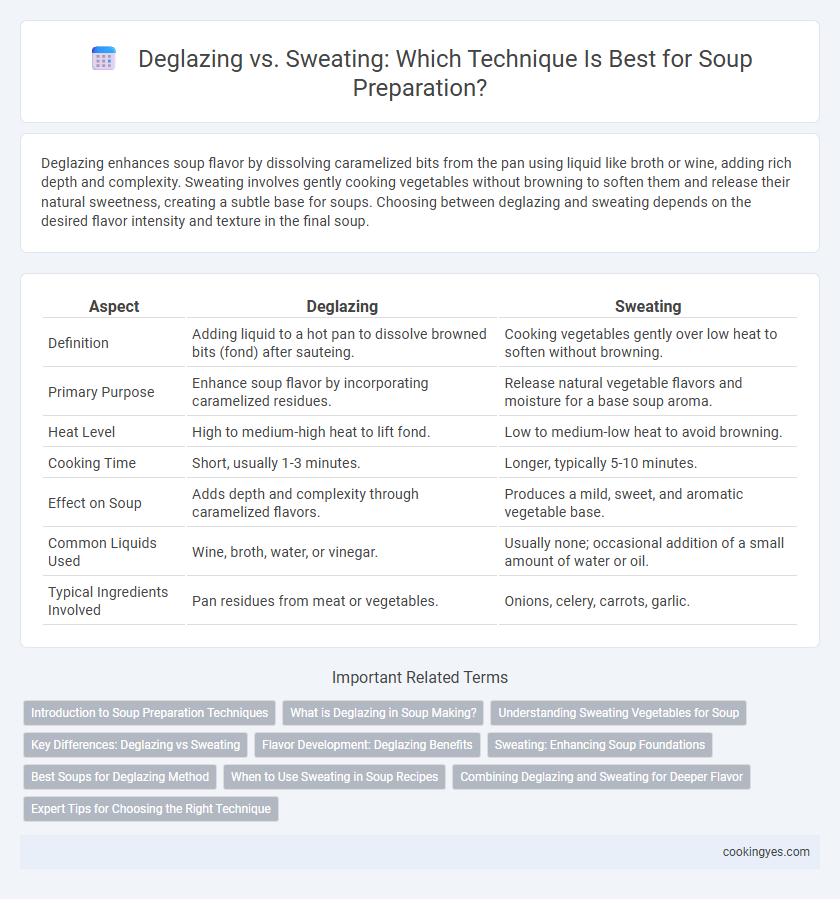Deglazing enhances soup flavor by dissolving caramelized bits from the pan using liquid like broth or wine, adding rich depth and complexity. Sweating involves gently cooking vegetables without browning to soften them and release their natural sweetness, creating a subtle base for soups. Choosing between deglazing and sweating depends on the desired flavor intensity and texture in the final soup.
Table of Comparison
| Aspect | Deglazing | Sweating |
|---|---|---|
| Definition | Adding liquid to a hot pan to dissolve browned bits (fond) after sauteing. | Cooking vegetables gently over low heat to soften without browning. |
| Primary Purpose | Enhance soup flavor by incorporating caramelized residues. | Release natural vegetable flavors and moisture for a base soup aroma. |
| Heat Level | High to medium-high heat to lift fond. | Low to medium-low heat to avoid browning. |
| Cooking Time | Short, usually 1-3 minutes. | Longer, typically 5-10 minutes. |
| Effect on Soup | Adds depth and complexity through caramelized flavors. | Produces a mild, sweet, and aromatic vegetable base. |
| Common Liquids Used | Wine, broth, water, or vinegar. | Usually none; occasional addition of a small amount of water or oil. |
| Typical Ingredients Involved | Pan residues from meat or vegetables. | Onions, celery, carrots, garlic. |
Introduction to Soup Preparation Techniques
Deglazing enhances soup flavor by dissolving browned food residue with liquid, adding depth and complexity, while sweating gently cooks vegetables to release moisture and sweetness without browning. Mastering these techniques is essential for building rich, layered soup bases that elevate overall taste. Using appropriate heat control and timing ensures optimal texture and balance in soup preparation.
What is Deglazing in Soup Making?
Deglazing in soup making involves adding liquid, such as stock or wine, to a hot pan after sauteing ingredients to dissolve browned food bits stuck to the bottom, enhancing flavor depth. This technique captures the concentrated essence of caramelized residues, enriching the soup's savory profile with complex, robust notes. Deglazing is essential for building layered flavors before adding additional liquids or ingredients to the soup base.
Understanding Sweating Vegetables for Soup
Sweating vegetables involves gently cooking them in fat over low heat to soften and release their flavors without browning, which is essential for developing a delicate base for soups. This process preserves the natural sweetness and moisture of ingredients such as onions, carrots, and celery, enhancing the soup's overall depth and clarity. Mastering the technique of sweating ensures a balanced foundation that supports subsequent layering of flavors in soup preparation.
Key Differences: Deglazing vs Sweating
Deglazing in soup preparation involves adding liquid, such as broth or wine, to a hot pan to dissolve browned food residue, enhancing the soup's depth of flavor. Sweating refers to gently cooking vegetables over low heat without browning, allowing them to soften and release moisture, creating a subtle base for soups. Both techniques impact the soup's taste and texture but differ in heat level, purpose, and outcome.
Flavor Development: Deglazing Benefits
Deglazing enhances soup flavor by dissolving browned fond from the pan, releasing rich, concentrated taste compounds that intensify the overall profile. This technique captures caramelized sugars and savory bits, creating depth and complexity that sweating alone cannot achieve. Incorporating deglazed liquids, such as wine or broth, boosts umami and aroma, elevating the soup's sensory appeal.
Sweating: Enhancing Soup Foundations
Sweating vegetables gently releases their natural moisture and enhances the base flavors without browning, making it ideal for delicate soup preparation. This technique preserves the subtle sweetness of ingredients like onions, carrots, and celery, creating a rich and aromatic foundation. Sweating ensures a balanced flavor profile that supports complex soups without overpowering the final dish.
Best Soups for Deglazing Method
Deglazing enhances soups like French onion and mushroom barley by extracting rich, caramelized flavors from browned ingredients. This method is ideal for broths and stews where deep, savory complexity is desired, often involving wine, stock, or vinegar to lift fond residues. Soups with roasted vegetables or meats benefit significantly from deglazing, resulting in a more robust and layered taste profile.
When to Use Sweating in Soup Recipes
Sweating is ideal for soup preparation when gently softening vegetables to release their natural sweetness without browning, preserving a delicate flavor profile. This technique is commonly used at the beginning of recipes that require a clear or light broth, such as vegetable or chicken soups. Choosing sweating over deglazing helps maintain the soup's clarity and subtle aroma by avoiding caramelization.
Combining Deglazing and Sweating for Deeper Flavor
Sweating vegetables gently releases their natural flavors and softens their texture, creating a flavorful base for soups, while deglazing with wine, broth, or vinegar lifts the browned bits from the pan, infusing the soup with rich, complex aromas. Combining sweating and deglazing techniques enhances the depth of flavor by layering subtle sweetness and savory notes from caramelized sugars and concentrated juices. This method maximizes the extraction of umami and aromatic compounds, resulting in a soup with greater richness and nuanced taste.
Expert Tips for Choosing the Right Technique
Deglazing enhances soup by dissolving browned bits from the pan with liquid, creating a rich, complex flavor, ideal for hearty broths and stews. Sweating gently cooks aromatics like onions and garlic without browning, preserving their sweetness and texture, perfect for delicate soups and clear broths. Expert chefs recommend deglazing when building depth and complexity, while sweating is best for maintaining subtle flavors and clarity in the soup base.
Deglazing vs Sweating for soup preparation Infographic

 cookingyes.com
cookingyes.com